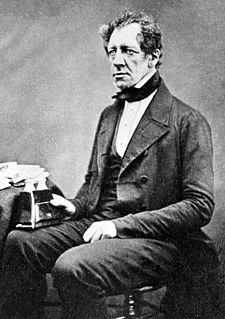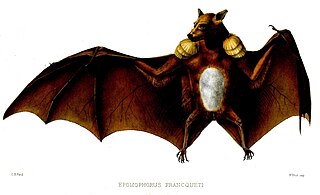
George Robert Gray FRS was an English zoologist and author, and head of the ornithological section of the British Museum, now the Natural History Museum, in London for forty-one years. He was the younger brother of the zoologist John Edward Gray and the son of the botanist Samuel Frederick Gray.

The imperial woodpecker is a woodpecker species endemic to Mexico. If it is not extinct, it is the world's largest woodpecker species, at 56–60 cm (22–23.5 in) long. Researchers have discovered that the imperial woodpecker has slow climbing strides and a fast wing-flap rate compared with other woodpeckers. Owing to its close taxonomic relationship, and its similarity in appearance, to the ivory-billed woodpecker, it is sometimes called the Mexican ivory-billed woodpecker, but this name is also used for the extant pale-billed woodpecker. The large and conspicuous bird has long been known to the native inhabitants of Mexico and was called cuauhtotomomi in Nahuatl, uagam by the Tepehuán and cumecócari by the Tarahumara.

Alfred Malherbe was a French magistrate and amateur naturalist born in Mauritius to Pierre Marie François Malherbe and Rosalie Le Meusnier Molineuf. The family originally came from Metz. Alfred became the administrator of the Museum of Metz.

Francis Walker was an English entomologist. He was born in Southgate, London, on 31 July 1809 and died at Wanstead, England on 5 October 1874. He was one of the most prolific authors in entomology, and stirred controversy during his later life as his publications resulted in a huge number of junior synonyms.

Alexander Henry Haliday was an Irish entomologist. He is primarily known for his work on Hymenoptera, Diptera, and Thysanoptera, but worked on all insect orders and on many aspects of entomology.

Eacles imperialis, the imperial moth, is a Nearctic member of the family Saturniidae and subfamily Ceratocampinae. The species was first described by Dru Drury in 1773.

Pachycrocuta was a genus of prehistoric hyenas. The largest and most well-researched species is Pachycrocuta brevirostris, colloquially known as the giant short-faced hyena as it stood about 90–100 cm (35–39 in) at the shoulder and it is estimated to have averaged 110 kg (240 lb) in weight, approaching the size of a lioness, making it the largest known hyena. Pachycrocuta first appeared during the late Miocene and became extinct during the middle Pleistocene, 400,000 years ago.

Teinopalpus imperialis, the Kaiser-i-Hind, is a rare species of swallowtail butterfly found from Nepal and north India east to north Vietnam. The common name literally means "emperor of India". The Kaiser-i-Hind is much sought after by butterfly collectors for its beauty and rarity. The green iridescence of the wings has been found to be due to three-dimensional photonic structure of the scales and is the subject of much research.

Adam White was a Scottish zoologist.

Franquet's epauletted fruit bat is a species of megabat in the family Pteropodidae, and is one of three different species of epauletted bats. Franquet's epauletted fruit bat has a range of habitats, varying from sub-saharan forest to equatorial tropics.

Rutilia is a large genus of medium to large (>20mm) flies in the family Tachinidae native to Australia and the Oriental region, though notably absent from New Zealand. Like the vast majority of tachinid flies, Rutilia species are parasitoids of other insects, specifically Rutilia are known to be parasitoids of late instar larvae of scarab beetles.

Cymbiola is a genus of large predatory sea snail, a marine gastropod mollusk in the family Volutidae, the volutes.

Franklandia is a genus of small shrubs in family Proteaceae, commonly known as lanolin bushes. It is endemic to Southwest Australia.

Phyllodes imperialis, the imperial fruit-sucking moth or pink underwing moth, is a noctuoid moth in the family Erebidae, subfamily Calpinae. It was first described by Herbert Druce in 1888. The species can be found in north-eastern Queensland to northern New South Wales, Papua New Guinea, Solomons, Vanuatu and New Caledonia.

Gymnopilus maritimus is a fungus species of the family Cortinariaceae first collected in northern Sardinia, Italy, in 2006. The species produces moderately sized, sturdy mushrooms of a reddish-orange colour. The cap, which can measure up to 70 millimetres (3 in) across, is covered in orange fibrils, and sometimes has small scales. The yellowish stem measures up to 110 mm (4 in) in length by 8 mm (0.3 in) in width, and sometimes shows remnants of the partial veil. The mushrooms have thick gills of a variable colour, ranging from yellow to rust but staining darker, and the yellow flesh has a mild taste. The mushrooms leave a rusty-brown spore print, while the spores themselves measure from 7.5–11.5 micrometres (0.00030–0.00045 in) in length. The species is most similar in appearance to G. arenophilus and G. fulgens, but can be differentiated from both morphologically. Despite the similarities, it is not closely related to either, suggesting convergent evolution. Instead, within the genus Gymnopilus, it is most closely related to the spectabilis–imperialis clade. However, it is not particularly similar to any of its closest relatives.

Pteranodontoidea is an extinct clade of ornithocheiroid pterosaurs from the Early to Late Cretaceous of Asia, Africa, Europe, North America and South America. It was named by Alexander Wilhelm Armin Kellner in 1996. In 2003, Kellner defined the clade as a node-based taxon consisting of the last common ancestor of Anhanguera, Pteranodon and all its descendants. The clade Ornithocheiroidea is sometimes considered to be the senior synonym of Pteranodontoidea, however it depends on its definition. Brian Andres in his analyses, converts Ornithocheiroidea using the definition of Kellner (2003) to avoid this synonymy.

Lycorma is a genus of insects in the family Fulgoridae: subfamily Aphaeninae; species are native to Asia. L. delicatula, known as the spotted lanternfly, is an invasive species in North America.

Sanaa is a genus of bush-crickets found in India, Indo-China and Malesia. It belongs to the tribe Cymatomerini within the subfamily Pseudophyllinae. It may be confused with the genus Parasanaa, which has a similar distribution in Asia.

Costelytra zealandica is a species of scarab beetle found in forested areas of greater Wellington. It was originally described in 1846 by the British entomologist Adam White as Rhisotrogus zealandicus from a specimen obtained during the Ross expedition. The species is known to feed on roots of plants and trees, so is considered a pest for many farm pastures.

Lycorma imperialis is a planthopper insect indigenous to parts of China and Indo-Malaysia. L. imperialis was originally discovered in 1846 by Adam White and has one recognized non-nominate subspecies, L. i. punicea. L. imperialis has undergone a number of reclassifications since its discovery and is one of four species in the genus Lycorma. L. imperialis follows a hemimetabolous life cycle and will undergo a series of nymphal stages (instars) before maturing to an adult.




















